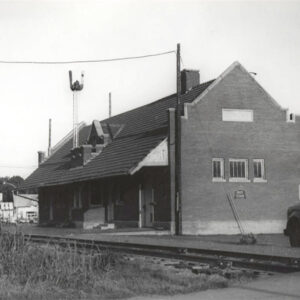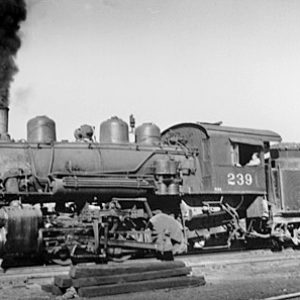calsfoundation@cals.org
Chicago, Rock Island and Pacific Railway
The Chicago, Rock Island and Pacific Railroad (commonly called the Rock Island) was an Illinois railroad that gained access to Arkansas in 1902. Its purchase of the Choctaw, Oklahoma and Gulf Railroad gave it the beginnings of a transcontinental route along the thirty-fifth parallel and the beginnings of a route to the Gulf of Mexico at New Orleans. Ultimately, the railroad would purchase more than thirty-two separate railroads to create a network in Arkansas that was more than 700 miles long, with railroad lines in the Mississippi River Delta and the Arkansas Grand Prairie representing the importance of agricultural products to its business. Oil from southern Arkansas, coal from western Arkansas, and lumber products from central and southern Arkansas were also significant commodities for the railroad. Poor management, lack of investment, and competition with other railroads caused a gradual decline, and, in 1980, a bankruptcy court ordered the railroad sold to pay debts.
The Choctaw and Memphis Railroad Company reported in 1899 that its newly purchased Memphis and Little Rock Railroad line was 131 miles long and had revenues of $487,215. The owners of the railroad, based in Little Rock (Pulaski County), were already planning a 152-mile extension of the railroad from that city to the border of the Indian Territory near Fort Smith (Sebastian County). By the early 1900s, this expansion caught the attention of the Chicago, Rock Island and Pacific Railroad.
The Rock Island began in Illinois as the Rock Island and LaSalle Railroad Company in 1847. In 1851, desirous of connecting Chicago and Rock Island, Illinois, it changed its name and charter to the Chicago and Rock Island Railroad Company. Seeking to incorporate the purchase of a number of Midwestern railroads, the railroad was reorganized as the Chicago, Rock Island and Pacific Railroad Company in 1866. The Rock Island remained a Midwestern railroad through the end of the nineteenth century when, under the control of what is often called the Reid-Moore Syndicate, the Rock Island began a period of intense and often complex growth.
It was during this time that the Rock Island sought both a route to the Pacific Ocean and a route to the Gulf of Mexico. In Arkansas, the company found the beginnings of both. In 1902, the Choctaw, Oklahoma and Gulf Railroad (CO&G), successors to the Choctaw and Memphis, operated a rail line from Memphis, Tennessee, to Texola, Oklahoma. Additionally, it controlled the White and Black River Valley Railroad Company between Brinkley (Monroe County) and Newport (Jackson County). The CO&G line ran from Hopefield (Crittenden County) through Brinkley, Carlisle (Lonoke County), and Lonoke (Lonoke County) to Little Rock. From Little Rock, it ran west toward Perry (Perry County), Ola (Yell County), Danville (Yell County), Havana (Yell County), Blue Mountain (Logan County), Mansfield (Sebastian County), Hartford (Sebastian County), and into Oklahoma.
With access to the abundant agricultural areas of eastern Arkansas, sawmills and forests of central Arkansas, and the coal fields of western Arkansas, the CO&G was a profitable railroad. In 1890, a subsidiary company, the White and Black River Valley Railroad, was shipping 1,500 to 2,000 tons of cotton seed and 4,000 to 7,000 bales of cotton each year. The Rock Island purchased a controlling number of CO&G shares in May 1902. Seizing an opportunity to increase passenger traffic, the Rock Island purchased the Hot Spring Western Railroad, giving it access to the spas and resorts of Hot Springs (Garland County).
The incorporation of the wholly owned subsidiary—Rock Island, Arkansas and Louisiana in 1905—combined four existing Arkansas railroads. With these railroads and construction of 200 miles of new track, the Rock Island completed its line to Eunice, Louisiana, and finished expansion south from Little Rock through Fordyce (Dallas County), Tinsman (Calhoun County), and El Dorado (Union County), with branch lines to Camden (Ouachita County) and Crossett (Ashley County).
Under the Reid-Moore Syndicate, the railroad combined thirty-two Arkansas railroads to form the complex Rock Island network in the state. Among others, it purchased the twenty-four-mile-long Searcy and Des Arc Railroad and the partially completed Hazen and Northern between Des Arc (Prairie County) and Mesa (Prairie County).
In Arkansas, the Rock Island of the 1910s was a well-built, well-connected railroad. The company’s Choctaw Route stretched from Memphis to Little Rock to Tucumcari, New Mexico. It carried significant amounts of agricultural products from the Grand Prairie and the Delta. In the western part of the state, the Rock Island served numerous coal mines, shipping thousands of cars of coal to Midwestern cities. After oil was discovered at El Dorado in 1921, the Rock Island transported ninety percent of the barrels of oil produced that first year. By 1930, the Rock Island system in Arkansas was 705 miles long and valued at $11,962,699.
Nevertheless, by 1933, the Rock Island was in receivership. The Great Depression, coupled with mismanagement that began under the Reid-Moore Syndicate, doomed the railroad to bankruptcy for the second time in thirty years—the first being in 1915. Passenger trains such as the streamlined Choctaw Rocket (Memphis to Los Angeles, California, by way of Little Rock), the Memphis-Californian, and the Hot Springs Limited helped increase and maintain passenger traffic in Arkansas through the 1940s. The railroad emerged from receivership in 1948 (and purchased the sixteen-mile-long Warren and Ouachita Valley Railroad that same year) and continued to operate a slowly shrinking network of lines in Arkansas.
The last year the railroad earned a profit was 1965, and passenger service ceased in 1967. By 1975, the Rock Island was again bankrupt. In August 1979, its clerks went on strike, paralyzing the railroad. President Jimmy Carter’s order for the strikers to return to work was ignored in September 1979. Bankruptcy judge Frank J. McGarr of Chicago ordered the railroad liquidated in January 1980, and the last train ran in March of that year. It was the largest liquidation of any American company to that point. Much of the Rock Island track in Arkansas was removed in the early 1980s, but portions continued to be operated by the St. Louis Southwestern. Today, a significant portion of the former Choctaw Route is operated by the Union Pacific between Brinkley and West Memphis and also by the Little Rock and Western between Little Rock and Danville.
For additional information:
Hayes, William Edward. Iron Road to Empire: The History of 100 Years of Progress on the Rock Island Lines. Newton, IA: CPM LLC, 2000.
Hibblen, Michael E. Rock Island Railroad in Arkansas. Charleston, SC: Arcadia Publishing, 2017.
Jones, Luke. “A Mighty Good Road.” Arkansas Business, July 30–August 5, 2012, pp. 1, 13–15.
Kent, Carolyn Yancey. “A Fatal Collision on the Rock Island.” Pulaski County Historical Review 71 (Fall 2023): 98–100.
Nelson, John H. ed. 1922 Rock Island Magazine Reprint. Newton, IA: CPM LLC, 2000.
Rock Island Reporter. https://rockislandreporter.com/ (accessed April 6, 2022).
Schneider, Gregory L. Rock Island Requiem: The Collapse of a Mighty Fine Line. Lawrence: University Press of Kansas, 2013.
Wood, Stephen E. “The Development of Arkansas Railroads.” Arkansas Historical Quarterly 7 (Summer 1948): 103–118.
———. “The Development of Arkansas Railroads.” Arkansas Historical Quarterly 7 (Autumn 1948): 155–193.
Van Zbinden
Arkansas Historic Preservation Program
 Rock Island Bridge (Little Rock–North Little Rock)
Rock Island Bridge (Little Rock–North Little Rock) Lonoke Rock Island Depot
Lonoke Rock Island Depot  Poyen Depot
Poyen Depot  Railroad Prairie Natural Area
Railroad Prairie Natural Area  Rock Island Diesel Switcher
Rock Island Diesel Switcher  Rock Island Locomotive
Rock Island Locomotive  Weldon Depot
Weldon Depot 




This write-up covers many of the negatives of the Rock Island (poor management, eventual liquidation, etc.) but fails to mention a couple of historic “firsts.” The Rock Island was the first railroad to utilize a diesel locomotive in Arkansas, when diesel switchers were assigned to the Little Rock passenger station and adjacent “city” yard. Also, the Rock Island was the first railroad to operate a diesel-powered streamliner through Arkansas, with the inauguration of the Choctaw Rocket in November 1940. It’s a paradox that a railroad sufficiently advanced to be first in these rail industry watershed events would find itself largely liquidated forty years later.
The Arkansas Democrat of July 27, 1938, carried a photograph and short article about Rock Island diesel switcher #523, one of two such diesels which had just been placed in service in Little Rock. This operation predated the Missouri Pacific’s first diesel switchers in Arkansas by approximately 18 months. The Rock Island inaugurated the streamlined, diesel-powered passenger train Choctaw Rocket on November 17, 1940, with newspaper coverage in both Little Rock papers during the few days prior and subsequent to that date. This was the first diesel streamliner to serve Arkansas. Missouri Pacific’s first diesel streamliner in Arkansas, the Delta Eagle (on an unlikely Memphis-Helena-Tallulah, LA route) began service May 11, 1941.